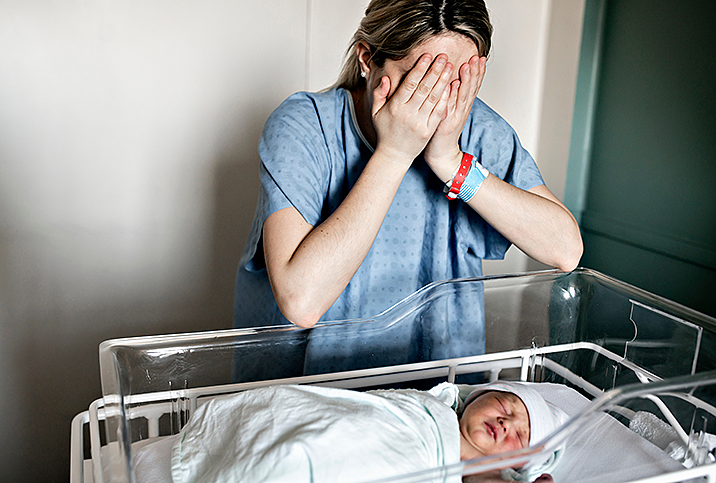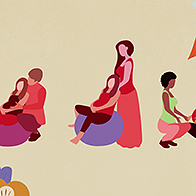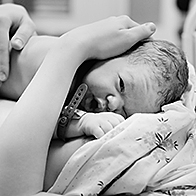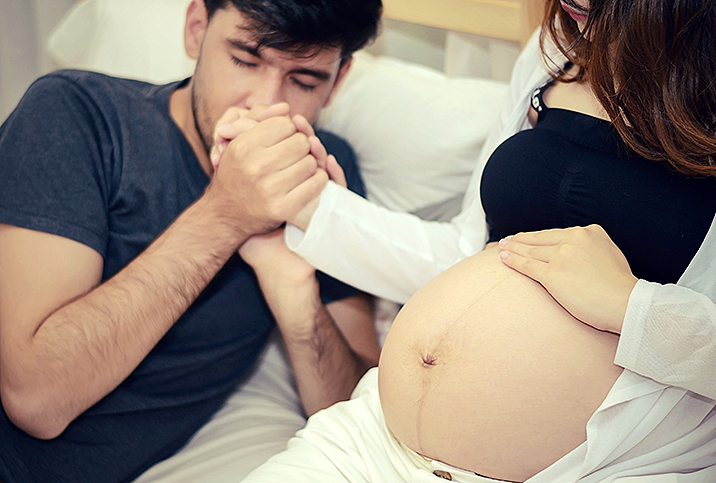How a Traumatic Birth Can Have Lasting Effects on New Mothers

Tanya Wrafter, of the United Kingdom, went through two challenging deliveries before she finally had the birth experience she had "always dreamed of" having. Thanks to a birth plan and the advice of a doula, she was able to avoid a traumatic birth for her third pregnancy.
Approximately 30,000 women each year in the U.K. experience traumatic birth—defined as a type of post-traumatic stress disorder (PTSD) that occurs after giving birth—according to the Birth Trauma Association.
During her first pregnancy, Wrafter was told her baby was not compatible with life. She decided to continue carrying the pregnancy as long as the baby decided to stay. In survival mode and allowing "the baby to call the shots," at eight months pregnant her water broke. She still needed to be induced and a C-section was required to deliver her baby stillborn.
Wrafter quickly got pregnant again. Since she had already been through this journey once, she didn't think she'd need a birth plan. But she had received an epidural the first time around and hadn't felt the full force of the contractions.
"I was totally unprepared and felt like I couldn't handle the pain, like I couldn't breathe properly," she described of her second delivery. "In the end, I got a shot of pethidine to help things progress. It made me sick and I just felt not with it. It ended up a forceps birth after an episiotomy, and then I hemorrhaged."
'I was totally unprepared and felt like I couldn't handle the pain, like I couldn't breathe properly.'
After this experience, Wrafter said she couldn't even sit for a month and felt traumatized for most of the following first year. During her third pregnancy, she promised herself she'd do all she could to help herself—that's when she stumbled onto a doula's website.
"I loved how straightforward the tips were," Wrafter recalled of her experience on the site. "I told my partner to remind me not to clench my hands or jaw, and also concentrate on my breathing, which he did. That kept him involved and also made the contractions so much more bearable. I got up and walked and kept myself upright when it felt comfortable."
Wrafter had a quick labor with her third pregnancy and breathed her way through the contractions, shutting everything else out.
"I went from 3 [centimeters] to 10 in half an hour using just breathing, then I felt my body doing the work itself. I've never felt anything like it in three births; my body was pushing my baby out. I felt superhuman. I had a natural tear which healed so fast, I feel like I had adrenaline and oxytocin flowing for weeks after having such a successful birth," she said, adding the experience restored her confidence.
Tips from a doula and a doctor to help prevent a traumatic birth
Emma Armstrong, founder of the Naked Doula in Nottingham, United Kingdom, believes preparation is key to a successful birth. You can't control what happens, but you can influence it, she explained. Two people can have the same physical experience—be it a cesarean section or a medical intervention—but each can have a completely different emotional experience.
"It's really all down to understanding what our options are, what our rights are and what our body's doing," she said. "People are going in there not knowing what to expect and not knowing what they can say no to, or unable to make informed choices."
Hollywood and sex education showcase a dramatized picture around childbirth that sinks into our subconscious mind, creating fear, Armstrong explained.
"By the time [women] get to the point of preparing...they're having to unlearn everything they've learned throughout their lives," Armstrong said.
Understanding the physiology of birth can make the experience a lot smoother. The most important aspect is protecting your oxytocin. Known as the "love" hormone, oxytocin is released in response to touch, such as during sex, breastfeeding and labor.
"It's intimacy," Armstrong expanded. "The higher levels that your oxytocin is at during birth, the smoother your contractions will be, the faster your labor is going to be, and the less chance you're going to need any kind of intervention."
She explained that if we don't understand how our body works, and we're driven by fear, this can cause high blood pressure and tenseness in the body. A woman in labor then feels the contractions as continuous pain, which slows labor down and may lead to necessary interventions, such as a C-section. The body doesn't want to birth a baby into what it feels is a dangerous environment, Armstrong said.
"Once we understand the physiology and the basics of birth, that's when we can start preparing and we can influence our birth experience," she said.
A 2019 systematic review, including 51 studies from 22 countries, suggested that having a companion, such as a doula, during labor helps bridge the information gap between the mom-to-be and the healthcare professionals. As a reassuring presence and emotional support, a doula can help the woman vocalize her preferences and keep her ambulant and mobile during labor. This continuous support may result in less need for pain medications and an increased likelihood of vaginal delivery.
Deborah Lee, M.B.Ch.B., a sexual and reproductive health specialist at Dr Fox, an online pharmacy based in London, also highlighted the importance of preparation for labor and the arrival of the baby. Parenting and birthing classes teach the physiological process of pregnancy and labor, and help women prepare for both the birth and life as a new mom.
"Like most things in life, knowledge is power. By being fully informed, you can stay in control and are more likely to feel confident throughout the process and be better able to cope, whatever the outcome," Lee said.
Resources for recovering from a traumatic birth
Women should never feel guilty if something beyond their control goes wrong during labor, but help is available to anyone who experiences the symptoms of a traumatic birth in the weeks following delivery.
Lee listed some potential signs of birth trauma:
- Birth-related nightmares
- Panic attacks
- Vivid flashbacks
- Feeling numb or detached from the body
- Physical symptoms such as sweating, shaking or pain when recalling the event
- Feeling agitated, irritable and emotional
It's common to experience "postpartum blues" during the first few weeks after delivery, however, if it lasts longer than a couple of weeks, people should seek professional help, added Mariana Bodiu, Ms.C., a clinical psychologist with Plumm, a London-based online platform for mental health services.
"Therapy is one of the best ways to overcome a traumatic experience, as you have the guidance of a professional. If trauma is untreated, it can manifest itself in physical ways, leading to health conditions such as insomnia and chronic anxiety," Bodiu explained.
Take care of yourself, too
While there is no "one size fits all" solution to healing from a traumatic birth experience, Bodiu shared some useful practices: not aiming for perfection as a new parent, seeking support from family and friends, giving yourself a break, and leaving the house. She also highlighted the importance of diet, hydration and allowing yourself to feel your emotions.
"New moms often prioritize feeding their babies over feeding themselves, but it's important to keep high blood sugar to ensure your energy levels and mood doesn't plummet. Keep healthy snacks handy," Bodiu advised.
"Allow yourself to cry and laugh, all within a window of 10 minutes," she continued. "A good cry may not necessarily be a bad thing; it may be just what you need. Make sure you follow it up with something that makes you laugh. There's plenty of accessible content online or call up a friend to reminisce over a funny story."
Lee said every pregnancy and labor are likely to be very different, and having an episode of birth trauma repeated in a future pregnancy is unusual.
"There will be many decisions you and the team looking after you can make differently to try and ensure the same things don't happen again," she concluded.




















